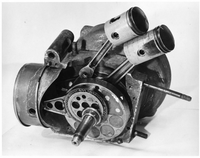








A two-stroke, or two-cycle, engine is a type of internal combustion engine which completes a power cycle with two strokes (up and down movements) of the piston during only one crankshaft revolution. This is in contrast to a "four-stroke engine", which requires four strokes of the piston to complete a power cycle. In a two-stroke engine, the end of the combustion stroke and the beginning of the compression stroke happen simultaneously, with the intake and exhaust (or scavenging) functions occurring at the same time.
Joseph Day advertised a new design of “valveless air compressor” which he made on licence from the patentee, Edmund Edwards. By 1889, he was working on an engine design which would not infringe the patents that Otto had on the four-stroke, and that he eventually called the Valveless Two-Stroke Engine. In fact there were two flap valves in Joseph Day’s original design, one in the inlet port, where you would probably find a reed valve on a modern two stroke, and one in the crown of the piston, because he did not come up with the idea of the transfer ports until a couple of years later. He made about 250 of these first two-port motors, fitting them to small generating sets, which won a prize at the International Electrical Exhibition in 1892.
It was one of Joseph Day’s workmen, Frederick Cock, who made the modification which allowed the skirt of the piston to control the inlet port and do away with valves altogether, giving rise to the classic piston ported two stroke. Only two of these original engines have survived, one in the Deutsches Museum in Munich,the other in the Science Museum in London.
Two-stroke petrol (gasoline) engine was very popular throughout the 19th-20th century in motorcycles and small-engined devices, such as chainsaws and outboard motors. They were also used in some cars, a few tractors and many ships. Part of their appeal was their simple design (and resulting low cost) and often high power-to-weight ratio. The lower cost to rebuild and maintain made the two stroke engine very popular, until for the USA their EPA mandated more stringent emission controls in 1978 (taking effect in 1980) and in 2004 (taking effect in 2005 and 2010). The industry largely responded by switching to four-stroke petrol engines, which emit less pollution.Most small designs use petroil (two-stroke oil)) lubrication, with the oil being burned in the combustion chamber, causing "blue smoke" and other types of exhaust pollution. This is a major reason why two-stroke engines were replaced by four-stroke engines in many applications.
Simple two-stroke petrol engines continue to be commonly used in high-power, handheld applications such as string trimmers and chainsaws. The light weight, and light-weight spinning parts give important operational and safety advantages. For example, a four-stroke engine to power a chainsaw operating in any position would be much more expensive and complex than a two-stroke engine that uses a gasoline-oil mixture.